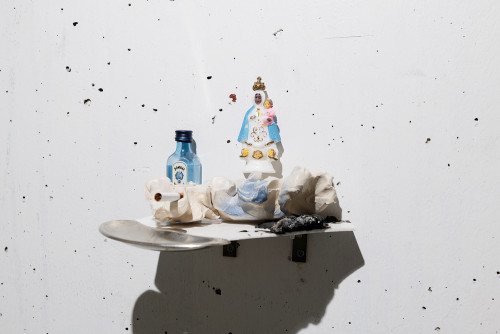
Floris Schönfeld, Oratwa pou Mambo Erzulie Danto, 2011. Photo: LNDW Studio.
Grenouille du Sang
June 27 – August 23, 2020
GAËLLE CHOISNE
JEAN ROUCH
FLORIS SCHÖNFELD
MARKUS SELG
NATALIA SORZANO
The exhibition Grenouille du Sang (blood frog) explores how ‘possession’— in Haitian Vodou as well as in other spiritual movements such as Hauka, Santeria and Winti—shape works of art and encouraged discussions around post-colonialism and exoticism. Through the figure of the zombie, the symbol of the snake and the veneration of the altar, the exhibition stimulates a spiritual journey where the body transforms and becomes a tool for reflection and healing.
The title of the exhibition Grenouille du Sang refers to the novel In the Palm of Darkness (1995) by Puerto Rican author Mayra Montero. The book recounts the story of two men, an American herpetologist and a Haitian guide, who are searching for the mythical and magical ‘Grenouille du Sang’: a blood-red Eleutherodactylus sanguineus, an elusive near extinct species of amphibian. The story is filled with zombies, madwomen, ghosts and witches, and offers an important contribution to postcolonial ecocriticism by drawing parallels between the various species of frogs that are disappearing and the tortured history of the Haitian people.
The zombie figure is an ideal figure to reflect on the relations between society and nature as it embodies a variety of cultural fears, ecological disasters, and political extremisms. The popular icon has its origins in the Haitian experience of slavery and the plantation economy, and was subsequently transformed into the fundamental symbol of alienation under capitalism. Haitian ethnologist and writer René Depestre summarised its relation by arguing that: The history of colonisation is the process of man’s zombification. In the exhibition, this process is embodied in Gaëlle Choisne’s film trilogy Cric Crac (2013–2015). She combines an extensive amount of archive material, found footage from the internet, and extracts from interviews to explore the figure of the zombie and its role in Haitian identity. Through these references from pop culture, vodou rituals and postcolonial studies, we discover that the zombie is still very much alive in Haiti, yet its image is filled with misconceptions and exoticism.
Vodou, also spelled Voodoo, Voudou, Vodun or in French: Vaudou, is a creole religion created by descendants of Dahomean, Congo, Yoruba and other African ethnic groups who were enslaved and brought to colonial Saint-Domingue (as Haiti was then called) and Christianised by Roman Catholic missionaries in the 16th and 17th centuries. The word Vodou means ‘spirit’ or ‘deity’ in the Fon language of the African kingdom of Dahomey (now Benin). Spirit possession plays an important role in Afro-Haitian religion, as in many other world religions. During religious rites, believers sometimes enter a trance-like state where the devotee can eat and drink, perform stylised dances, give supernaturally inspired advice to people, or perform medical healings or special physical achievements. In the example of the zombie, the concept of ‘possession’ in combination with the body can be understood by examining the relationship between African religions in the Atlantic and the capitalist-driven economies which shaped these cultures. As Silvia Federici stated in her 1998 book Caliban and the Witch: The human body, and not the steam engine, and not even the clock, was the first machine developed by capitalism.
Support
Grenouille du Sang is supported by the Municipality of Rotterdam and the Mondriaan Fonds.

Floris Schonfeld, Oratwa pou Mambo Erzulie Danto, 2011. Photo: LNDW Studio.

Gaëlle Choisne, Smoking Break, 2018. Photo: LNDW Studio.

Gaëlle Choisne, Smoking Break, 2018. Photo: LNDW Studio.

Markus Selg, Schlange (snake), 2015. Photo: LNDW Studio.

Natalie Sorzano, 1st Chapter: The Animal from Contesting Madness, 2019–2020. Photo: LNDW Studio.

Natalie Sorzano, 1st Chapter: The Animal from Contesting Madness, 2019–2020. Photo: LNDW Studio.

Natalia Sorzano, 1st Chapter: The Animal from Contesting Madness, 2019–2020. Photo: LNDW Studio.

Exhibtion view, Grenouille du Sang, 2020. Photo: LNDW Studio.

Jean Rouch, Les Maîtres fous, 1955. Photo: LNDW Studio.